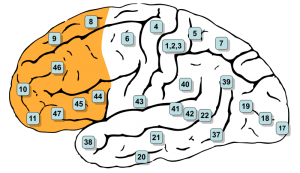
Mind Your Mind: Empowering Your "Inner CEO"
You start an email to your boss, “Dear total moron.” If a minute later you decide not to send it, you have one particular part of your brain to thank: your prefrontal cortex. This part of your brain is prime brain real estate. (It’s roughly speaking just behind your forehead and the thin layer marked in yellow in the image below.)
Your prefrontal cortex (PFC) is involved with executive functions such as planning, focusing attention, making decisions, initiating action, and inhibiting inappropriate action. For that reason, I call your PFC your inner CEO. Your PFC is largely responsible for stopping you from sending that nasty email to your boss.
Executive functions are abilities we desire at work. We want ourselves and those we work with to plan, pay attention, make decisions, initiate action, and stop unproductive actions. How can we empower our inner CEOs?
How to develop your inner CEO
Science says we can train our brains, and in a lasting way. Neuroplasticity is our brain’s ability to substantially rewire itself due to learning and experience. Studies led by Dr. Richard Davidson at the University of Wisconsin, for example, show neurons being added to the PFC and connections added between the PFC and the more emotional limbic system (including your amygdalae) in a matter of months. How can you train your brain to include a more powerful inner CEO? You can rewire with mindfulness.
Mindfulness may sound strange to you, conjuring up images of monks or martial artists. But mindfulness doesn’t have to be associated with any particular tradition. Being mindful is as simple as focusing your attention on one thing such as your breath, noticing when you are not paying attention any more, and without judgment, returning your attention.
Being mindful is less about sustaining perfect focus, and more about noticing sooner that your focus has drifted.

Physical balance is a good analogy here. Those with great balance don’t just stay perfectly balanced for long periods. They learn to notice sooner that they are leaning slightly to one side or another. They make smaller adjustments more frequently.
The same is true for those who are practiced at mindfulness. Their attention drifts as well, but they get good at noticing, and returning attention without judgment.
Judging yourself, “Darn it, I wasn’t focusing on breathing,” doesn’t help sustain your focus. To the contrary, judging uses a different part of your brain than sustaining attention. It diverts brain resources from your PFC and further delays your focus from returning where you want it.
Meditation is one practice to cultivate mindfulness. Meditation has many variations. One of the most common is called mindfulness of breathing meditation. This involves sitting still for a few minutes and focusing attention on your breath. Walking meditation is an alternative, where you walk slowly and focus your attention on how your feet feel.
Meditation leads to better health, self-regulation, and relationships
According to a number of studies, meditation leads to better physical and mental health, better self regulation, and better quality of relationships. Studies are clear: happier brains do better work. Happier people are more productive, creative, sociable, engaged, and successful. So investing time in meditation is empowering your inner CEO, so you improve health, self-regulation, and relationships and therefore happiness as well as productivity.
Don’t just do something—sit there!
It’s a good thing the benefits from meditation are so compelling. Otherwise hardly anyone with a career would give it a chance. Why would you take two minutes, never mind twenty, to sit and meditate when you have so much to do? But with science showing the many benefits, some are taking the phrase “Don’t just sit there. Do something,” and turning it around to “Don’t just do something. Sit there!”
If you haven’t tried it before, meditation looks on the outside like just sitting there. Specifically, you sit comfortably, with your hands either in your lap or on your knees. You may choose to close your eyes, or just focus on the floor or desk in front of you.
Although you are focusing on your breathing, you don’t need to breathe abnormally. Just focus your attention on the feeling of your breath, wherever you feel it: your nose, your throat, or your belly. Notice when thoughts arise, and they will, and gently return your attention to the feeling of your breath without judgment.
Various meditation timer apps can help you track how often you meditate and how much time you spend in each session.
Indeed, the ability to just sit there may be exactly the ability we need during some of work’s most stressful moments. Our boss is inappropriately ranting during a meeting or a customer is pressing our buttons and we just want to explode. An ability to ease the tension by focusing on the sensations of breathing may be just what our brains and our careers need.
Train your inner CEO with mindfulness, and experience the health, happiness, and career benefits that can result. That will help you spend less time dealing with the repercussions of sending emails that start with “Dear total moron.”
This blog was authored by Scott Crabtree and has been republished from http://positivepsychologynews.com.
References
Davidson, R. (2012). The Emotional Life of Your Brain: How Its Unique Patterns Affect the Way You Think, Feel, and Live–and How You Can Change Them. Plume.
Desbordes, G., Negi. L. T., Pace, T. W. W., Wallace, B. A., Raison, C. L. & Schwartz, E. L. (2012). Effects of mindful-attention and compassion meditation training on amygdala response to emotional stimuli in an ordinary, non-meditative state. Frontiers in Human Neuroscience. Abstract ends thus:
“This finding suggests that the effects of meditation training on emotional processing might transfer to non-meditative states. This is consistent with the hypothesis that meditation training may induce learning that is not stimulus- or task-specific, but process-specific, and thereby may result in enduring changes in mental function.”
Siegel, (2007). The Mindful Brain: Reflection and Attunement in the Cultivation of Well-Being. New York: W. W. Norton.
Puddicombe, A. (2012). 4 scientific studies on how meditation can affect your heart, brain and creativity. TED Talk.
Images
Prefrontal cortex from Wikimedia
Walking Meditation courtesy of Zoesdare
Back-bending balance courtesy of torbakhopper
Scott meditating courtesy of Sarah Crabtree

